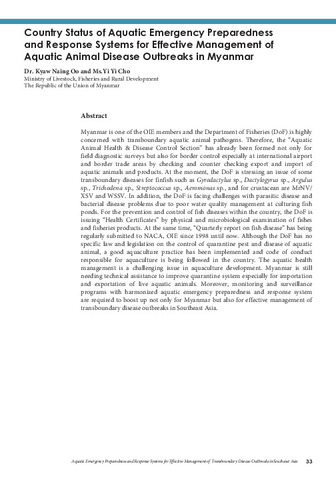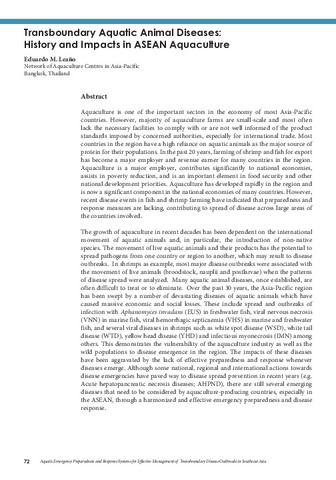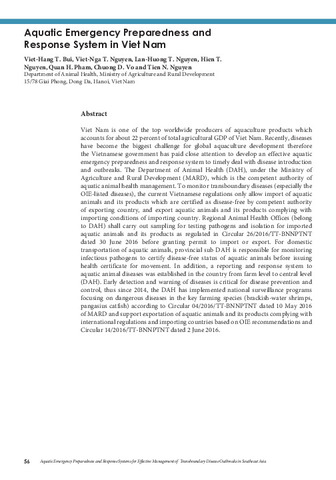| dc.contributor.author | Khan, Chan Dara | |
| dc.contributor.author | Chhorn, Sokleang | |
| dc.contributor.author | Thay, Somony | |
| dc.contributor.editor | Tendencia, Eleonor A. | |
| dc.contributor.editor | de la Peña, Leobert D. | |
| dc.contributor.editor | de la Cruz, Joesyl Marie V. | |
| dc.date.accessioned | 2019-07-23T08:09:27Z | |
| dc.date.available | 2019-07-23T08:09:27Z | |
| dc.date.issued | 2019 | |
| dc.identifier.citation | Khan, C. D., Chhorn, S., & Thay, S. (2019). Current status, issues, and gaps on aquatic emergency preparedness and response systems practiced by Cambodia. In E. A. Tendencia, L. D. de la Peña, & J. M. V. de la Cruz (Eds.), Aquatic Emergency Preparedness and Response Systems for Effective Management of Transboundary Disease Outbreaks in Southeast Asia: Proceedings of Asean Regional Technical Consultation, 20-22 August 2018, Centara Grand Central Ladprao, Bangkok, Thailand (pp. 7-11). Tigbauan, Iloilo, Philippines: Aquaculture Department, Southeast Asian Fisheries Development Center. | en |
| dc.identifier.isbn | 9789719931089 | |
| dc.identifier.uri | http://hdl.handle.net/10862/3456 | |
| dc.description.abstract | A few decades ago, Cambodia was rich in both freshwater and marine fisheries resources because of its favorable geographical area. However, the fisheries resources have depleted and were unable to totally fulfill the increasing fish demands of its people. This was caused by various factors including unfavorable climate changes, increase in population, improper agricultural production practices, and other human affecting activities. In this sense, aquaculture development in Cambodia becomes increasingly important in order to reduce the fishing pressure on its natural resources which are mainly for food security and economy of Cambodian people. Aside from this, aquatic animals in the country are vulnerable to infectious aquatic transboundary diseases as a result of insufficient and low transboundary diseases monitoring capacity. Neither the official list of aquatic transboundary diseases was created nor are the emergency preparedness and response systems for effective management of transboundary disease outbreaks in Cambodia has been well-established. Nonetheless, the government fisheries officers of both central and provincial levels have conducted fish health monitoring and undertake sample collection from fish farmers since 2016 in 10 targeted provinces as funded by the European Union s Programme. Regarding the capacity of the diagnostic laboratory, officers can perform level I and II but not for all species and diseases. Level III diagnoses cannot be effectively performed yet due to the lack of facilities, skills, and knowledge. The Marine Aquaculture Research and Development Center (MARDeC) is the only main laboratory for aquatic animal health diagnosis in the country. To minimize the spread of aquatic transboundary diseases in freshwater and seawater, the Ministry of Agriculture, Forestry and Fisheries has been moving to initiate and establish policies regarding: (1) the registrations, licensing, and law enforcement; (2) the inspection of sites; (3) and the issuance of health certificate and quality seals. However, those national regulations and legislation regarding the movement of aquatic animal stocks are not yet practical or effective. Importantly, the Royal Government of Cambodia needs both technical and financial assistance. It requires an improvement, amendment, and enforcement of the regulations, laws and the standard operating procedures (SOPs). It requires laboratory capacity building and SOPs for responsible management to establish the aquatic emergency preparedness and response systems for effective management of transboundary disease outbreaks in Cambodia as well as Southeast Asia. | en |
| dc.language.iso | en | en |
| dc.publisher | Aquaculture Department, Southeast Asian Fisheries Development Center | en |
| dc.subject | Cambodia | en |
| dc.title | Current status, issues, and gaps on aquatic emergency preparedness and response systems practiced by Cambodia | en |
| dc.type | Conference paper | en |
| dc.citation.spage | 7 | |
| dc.citation.epage | 11 | |
| dc.subject.asfa | disease control | en |
| dc.subject.asfa | Disease detection | en |
| dc.subject.asfa | disease resistance | en |
| dc.subject.asfa | disease transmission | en |
| dc.subject.asfa | epidemiology | en |
| dc.subject.asfa | husbandry diseases | en |
| dc.subject.asfa | aquaculture regulations | en |
| dc.subject.asfa | quarantine regulations | en |
| dc.subject.asfa | fishery regulations | en |
| dc.subject.asfa | safety regulations | en |
| dc.subject.asfa | response time | en |
| dc.subject.asfa | emergencies | en |
| dc.subject.asfa | fishing effort | en |
| dc.subject.asfa | marine fisheries | en |
| dc.subject.asfa | food security | en |
| dc.subject.asfa | fish | en |
| dc.subject.asfa | aquaculture development | en |
| dc.subject.asfa | capacity building | en |
| dc.subject.asfa | inspection | en |
| dc.subject.asfa | inland water environment | en |
| dc.subject.asfa | management | en |
| dc.subject.asfa | aquaculture | en |
| dc.subject.asfa | natural resources | en |
| dc.subject.asfa | vulnerability | en |
| dc.subject.asfa | Surveillance and enforcement | en |
| dc.subject.asfa | research | en |
| dc.subject.asfa | legislation | en |
| dc.subject.asfa | countries | en |
| dc.subject.asfa | stocks | en |
| dc.subject.asfa | Marine aquaculture | en |
| dc.subject.asfa | sea water | en |
| dc.subject.asfa | fresh water | en |
| dc.subject.asfa | fishing | en |
| dc.subject.asfa | diseases | en |
| dc.subject.asfa | aquatic animals | en |
| dc.subject.asfa | Catch-effort | en |
| dc.citation.conferenceTitle | Aquatic Emergency Preparedness and Response Systems for Effective Management of Transboundary Disease Outbreaks in Southeast Asia: Proceedings of Asean Regional Technical Consultation, 20-22 August 2018, Centara Grand Central Ladprao, Bangkok, Thailand | en |



